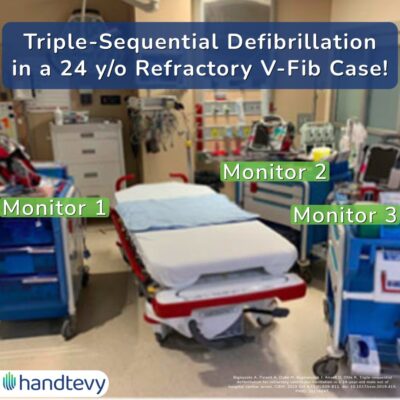Triple-Sequential Defibrillation: A Groundbreaking Intervention in Cardiac Arrest Management

In the realm of emergency medicine, innovation and persistence are crucial. A recent case has highlighted the extraordinary potential of a novel intervention: triple-sequential defibrillation. This groundbreaking technique was used to save the life of a 24-year-old male who experienced an out-of-hospital cardiac arrest with refractory ventricular fibrillation.
The Case Unfolds
Despite 82 minutes of high-quality CPR and Advanced Cardiovascular Life Support (ACLS) management, standard and dual-sequential defibrillation failed to restore the patient’s heartbeat. It was only through the innovative use of triple-sequential defibrillation that return of spontaneous circulation (ROSC) was finally achieved. Here’s a closer look at the remarkable case:
Case Highlights:
– The patient had a complete occlusion of his left anterior descending artery, which was identified and treated post-ROSC.
– The triple-sequential defibrillation, along with standard ACLS protocols and the administration of drugs like esmolol, played a pivotal role in overcoming refractory ventricular fibrillation.
Insights from the Study
Triple-sequential defibrillation involves the use of three defibrillators to deliver shocks simultaneously. This method, reported for the first time in this context, was considered after other interventions, including dual-sequential defibrillation and medication (esmolol), had failed.
– Innovation in Action: This technique was a last resort after all other methods proved ineffective.
– Successful Outcome: The successful application of triple-sequential defibrillation led to the patient’s discharge from the hospital 16 days later, neurologically intact.
Key Takeaways
– High-Quality CPR: This case underscores the critical importance of high-quality CPR in cardiac arrest management.
– Persistence in EMS: The perseverance and innovative thinking of the medical team were crucial in saving the patient’s life.
– Future Implications: While triple-sequential defibrillation is not yet a standard practice, its success in this case suggests that it could become an important tool in the future of emergency medical care.
Our Perspective
For now, we are continuing with dual-sequential external defibrillation (DSED) as our preferred method. However, the insights from this case are intriguing and may influence future practices in emergency medicine.
For those interested in diving deeper into this extraordinary case and its implications, you can read more about it here .
This remarkable case is a testament to the evolving nature of emergency medical care and the continuous quest for more effective interventions in life-threatening situations.

Peter Antevy, MD
DISCLAIMER: Pediatric Emergency Standards Inc. does not make clinical or medical decisions. The Handtevy System is intended to be utilized as a guide only. Provider’s experience and training should be the final determinant of clinical treatment decisions.

